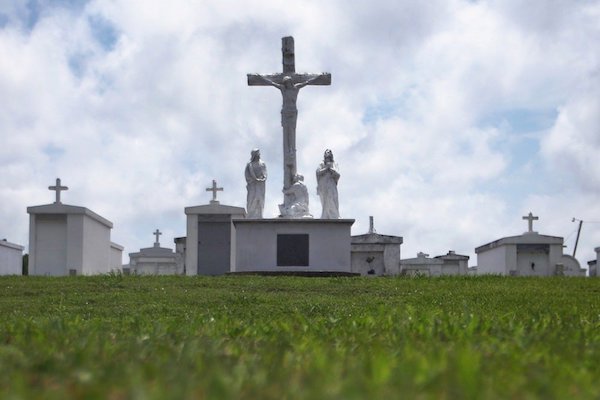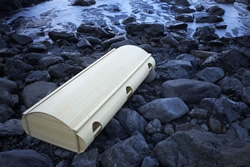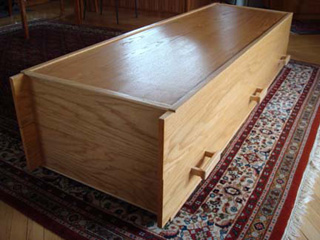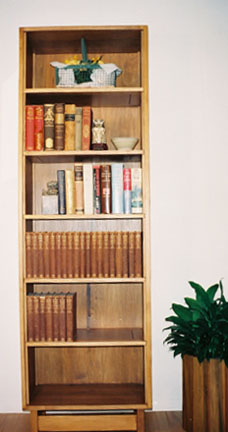The U.S. funeral industry is the most expensive and corporate in the world. Can Americans find a better way to grieve?
By
[I]n the six years since my father died, I’ve visited the cemetery where his ashes are interred exactly twice—the second time only because of the Jewish tradition of unveiling, where the initial graveside funeral service is followed within a year by a ceremony to uncover and dedicate the headstone. It’s not that returning would be too difficult. It’s more like the reverse: I fear an inability to perform the sadness and solemnity the pilgrimage seems to require. I miss my dad, but the cemetery, nestled alongside the highways and strip malls of suburban South Jersey, fails to evoke him in any meaningful way. It’s a site associated with him only retroactively, for the worst of all possible reasons. Where I’m supposed to feel his presence, there’s only a void.

Los Angeles-based mortician and writer Caitlin Doughty argues that such feelings result from the failures of America’s death industry, which has become “more expensive, more corporate, and more bureaucratic than any other on Earth.” According to the National Funeral Directors’ association, the median cost of traditional funeral with a viewing and burial was $7,181 in 2014; Doughty cites the current average at $8,000 to $10,000. 14 percent of US funeral homes are run by publicly traded firms. Service Corporation International, the largest funeral services provider in the US, operates over 2,000 funeral homes employing more than 24,000 people. The $20-billion industry often pushes grief to the margins by pressuring families to make a series of high-stakes decisions on a very short timeline—most funeral homes come to pick up a body within an hour of being contacted.
In some cases, funeral homes deliberately exploit families for financial gain at a time of profound vulnerability. A 2013 undercover investigation conducted by the Federal Trade Commission revealed that up to one in five American funeral homes engage in “deceptive and manipulative practices.” The offenders violated the 1984 Funeral Rule, which stipulates that funeral homes must provide itemized price lists. The compulsory bundling of products and services is prohibited: They can’t require that you buy a traditional varnished casket when all you want is a cremation; an inexpensive, unfinished wooden box must be made available. And the law bans the aggressive sale of products that are not required by law, like the use of a hearse to transport remains to a cemetery. Though most funeral homes keep dedicated websites, few display their prices online, which makes it challenging to compare costs.
With its focus on profits, the industry has also changed the way we treat dead bodies. As recently as a hundred years ago, “no one would have questioned a wife washing and dressing the body of her husband,” Doughty writes, “or a father carrying his son to the grave in a homemade coffin.” The Civil War is often identified as the point at which practices began to shift. Embalming became more common as soldiers’ bodies were transported from the South to the North. It gained even more popularity after Abraham Lincoln’s funeral train tour, which took his embalmed corpse to 180 cities between Washington D.C. and Springfield, Illinois. Now, the United States is the only country in the world in which chemical conservation of the dead is common practice—a process that can cost anything from $495 to over $1,000. What was once a practical solution with a historically specific context has become a profitable norm, despite, according to the CDC, providing no public health benefit.
In her book From Here to Eternity: Traveling the World to Find the Good Death, Doughty tries to find a better way to die and to grieve, seeking out death rituals from the Western United States to Japan, Spain, Indonesia, and beyond. It sounds a bit like Eat, Pray, Die, but her project is much larger than its premise first implies. She is searching not for personal spiritual enlightenment or the morbid titillation of thana-tourism, but for practical, radical alternatives to our corporatized death industry. Her travels illuminate a host of compelling possibilities for better funerals and a less fraught relationship with our dead. But the book also reveals a larger failure of our culture to allow for mourning and grieving after the last goodbye. If it is hard to navigate the death care industry, it is harder still to work out how to live with grief.
On her travels, Doughty finds many rituals that involve prolonged contact with corpses—prolonged, at least, by American standards. All around the world, she meets people less troubled by the physical reality of dead bodies, whether those bodies are burned to ash, mummified, “decomposting,” or lying under glass in their natural, un-embalmed state. In Japan she visits a corpse hotel where families may rent a suite that looks like an ordinary condo and “just be with the body, free from the performance required at a formal viewing.” And at the Rinkai crematory, Doughty learns about the practice of kotsuage. According to this custom, families are escorted into a room called a shūkotsu-shitsu after a cremation, where they pick up their loved one’s remaining bone fragments and place them gently into an urn.
In North Carolina, Doughty spends time at Western Carolina University’s Forensic Osteology Research Station (FOREST), where  corpses donated to science are turned into compost. The bodies are laid to rest in a wooded research facility, blanketed with alfalfa and woodchips, covered in a silver shroud, and in the hot sun to turn into dark, nutrient-rich soil after a period of weeks. The project is still in its experimental phase, but the FOREST researchers hope it will become a green solution with a therapeutic arc. Families will ultimately be invited to collect the soil made from the body of their loved one and with it, cultivate new life.
corpses donated to science are turned into compost. The bodies are laid to rest in a wooded research facility, blanketed with alfalfa and woodchips, covered in a silver shroud, and in the hot sun to turn into dark, nutrient-rich soil after a period of weeks. The project is still in its experimental phase, but the FOREST researchers hope it will become a green solution with a therapeutic arc. Families will ultimately be invited to collect the soil made from the body of their loved one and with it, cultivate new life.
Doughty finds her most extreme example of dead body positivity in Tana Toraja in Indonesia. For Torajans, the border between the living and the dead is porous. Corpses frequently remain in the home for a period of weeks, months, or even years, and are cared for like any other member of the family—bathed, fed, dressed, and spoken to. After they are finally buried, following elaborate community funerals, bodies are periodically exhumed during what is called the ma’nene’. Families have the opportunity to reunite, and even picnic, with their dead; they can make animal sacrifices they may not have been able to afford at the time of the original burial. What sounds grisly to some is, to the Torajans, both tender and sacred: “Hauling someone out of their grave years after their death is not only respectful,” Doughty writes, “but it provides a meaningful way to stay connected to their dead.”
Doughty’s chatty calm in the presence of dead bodies and her arguments against American squeamishness are admirable. But it feels, at times, like From Here to Eternity’s focus on death comes at the expense of grief. This is not a failure of the project so much as its shape; the nature of Doughty’s inquiry makes grief a secondary concern. It does appear sporadically: In the chapter on the Day of the Dead, she travels to Mexico with her friend Sarah to visit a mummy museum, as well as the altars families erect to honor the people they’ve lost that year. Sarah is still reeling from the decision to obtain a late-term abortion when her fetus was diagnosed with trisomy 13, and Doughty writes about the isolation of Sarah’s grief, her feeling that the inability to move on from the loss had made her “radioactive” to her friends and coworkers. Her loss, and the future she had imagined, is devastatingly rendered. There is a digression, too, on the Western funeral industry’s fixation on “dignity,” by which they really mean silence, composure, and repression—this, too, is a moment of genuine feeling, and Doughty shows that though her tone is often light, she has the capacity to move and enrage.
But just as often, Doughty fails to engage with the realities of mourning. At an open-air cremation she attends in Crestone, Colorado, she professes to witness the “pall of grief [lifting] from the circle.” I don’t doubt the power of this ceremony. But the implication that it was able to dispel sadness—that such a thing is possible, or even desirable, at a funeral—gives me pause. Worse, in the book’s epilogue, she writes, “A sense of purpose helps the mourner grieve. Grieving helps the mourner begin to heal.” This is a neat, linear progression; in other words, it’s exactly what the experience of grief is not.
There is more to death and dying than funerals. From Here to Eternity is in some ways a missed opportunity to explore how the profit motive has distorted our experience of death—not just burial, but all the feeling that comes after a body is buried. In The Last Word, Julia Cooper writes of the difficulty of grieving under late capitalism. The amorphous, endless, and unpredictable nature of grief puts it fundamentally at odds with pressures “to be efficient, to progress, to—most of all—get back to work.” But, she writes, “mourning doesn’t work that way. There is no timeline because the work of grieving is never done. There is nothing efficient or productive about loss, but there it is all the same.” Grieving is the enemy of work, and we’re expected to suppress the former in the interest of the latter.
Minimizing the pain of personal loss, Cooper argues, is in service of “maintaining productivity for the benefit of a capitalist system.”  Public displays of grief are shunned in part because they undermine the relentless positivity our economic system feeds on. The isolation of those who are unable to successfully curb their mourning is “a socially enforced strategy of our neoliberal era.” The repression of grief is also materially enforced: The standard paid bereavement leave, where it does exist, is three days. At Facebook, COO and Lean In author Sheryl Sandberg changed the company’s bereavement policy following the sudden death of her husband in 2015; the company now offers employees a comparatively generous 20 days paid leave following the loss of an immediate family member.
Public displays of grief are shunned in part because they undermine the relentless positivity our economic system feeds on. The isolation of those who are unable to successfully curb their mourning is “a socially enforced strategy of our neoliberal era.” The repression of grief is also materially enforced: The standard paid bereavement leave, where it does exist, is three days. At Facebook, COO and Lean In author Sheryl Sandberg changed the company’s bereavement policy following the sudden death of her husband in 2015; the company now offers employees a comparatively generous 20 days paid leave following the loss of an immediate family member.
In the op-ed Sandberg wrote for The New York Times about her children’s experience of bereavement, she talks about grief in the language of business. The death of a parent is “adversity”; the word “resilience” is used six times, while “grieving” makes one appearance. Sandberg writes of her son and daughter’s loss (and her own) alongside the story of a friend’s child who was bullied at summer camp, with the implication that both experiences can be “overcome” with the same set of therapeutic tools. Sandberg’s approach isn’t insincere; original or not, the idea that “there is no wrong way to grieve” is an important one. But for those who don’t find this way of thinking helpful, our culture offers few other ways to address grief and work.
Caitlin Doughty’s mission to reimagine the death industry—to cast out our shame and fear of the dead—is an important one, for which she makes the case well and with good humor. More humane and meaningful rituals around death would doubtless ease the transition into the new reality that awaits the living after a traumatic loss. For my part, I look forward to one day spreading what I’ve kept of my father’s ashes, at a site less dour than a New Jersey tomb. But reforming our funeral industrial complex is only the beginning of the work ahead of us.
Complete Article ↪HERE↩!















